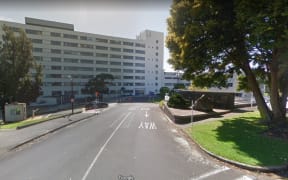Major hospital buildings in Hamilton, including the child and women's health centre, do not have warrants of fitness because they are not up to scratch for fire protection.

Waikato Hospital Photo: Supplied / Facebook
Other buildings do have warrants but also have multiple defects in firestopping. These include the outpatients Meade Clinical Centre that opened just five years ago.
Documents released under the Official Information Act show problems extending across the Waikato District Health Board's main Waiora campus in the city and at outlying sites such as Thames, Te Kuiti and Morrinsville.
Many buildings have multiple holes and gaps that compromise the fire-rating of walls and ceilings, by allowing flames and smoke to spread more quickly than they should.
These include:
- Hamilton hospital's Elizabeth Rothwell building that houses the children's clinics, women's health and birthing, and has not had a warrant of fitness for more than a year.
- The Acute Services building and Emergency Department, where the WOF expired in January 2018.
- The nearby Lomas building which has cancer services.
- The nearly new Meade outpatients block, opened in 2014, but which has multiple penetrations from cables that aren't properly sealed.
The OIA response includes an email two years ago in which the Hamilton City Council told the DHB that the delays around warrants of fitness was an issue "of public safety and it is imperative now that it is dealt with expeditiously".
But as of November 2018, 14 buildings did not have a warrant of fitness due to firestopping problems.
Read the Waikato DHB's full OIA response here
A half dozen major buildings are being repaired, including the Acute Services Building that houses the Emergency Department. It had firewalls in its main entrance that did not continue all the way up above the fire doors.
The DHB put a passive fire repair plan in place two years ago; as far back as six years ago it began work on the 10-level Menzies building.
But at Menzies, "the most recent inspection has identified more penetration issues which we are addressing", the DHB's OIA response said.
The Hamilton City Council has been cajoling the DHB since at least 2017 to fix things faster. But the DHB said at no stage had the council served it any "formal notices, advice or actions".
The DHB property head Chris Cardwell defended the hospital's fire protection measures, saying they had detectors, alarms and sprinklers, and stressing that firestopping "is just one component of the whole picture".
"So I think it would be a little unfair to say fire protection was not up to standard," he said.
However, Mr Cardwell also conceded that poor firestopping could mean fires spread faster than DHB evacuation plans allowed for.
The DHB's own worksheets say regarding multiple holes found at Thames's hospital's Manaaki centre three months ago:
"Firestop doors installed but large open areas above the doors where fire can simply move up and over the door and spread.
"Areas need to be sealed off to slow spread of fire."
Other hospital buildings in Hamilton and at Te Kuiti , Morrinsville and Te Awamutu are known to have similar problems, though they are yet to undergo full inspections.
Many of the problem buildings have no sprinklers in the ceiling cavities, like more modern hospitals do.
A DHB fire risk assessment in 2017 listed 16 buildings, and put 11 in a "normal" or moderate risk category; none in high risk and six in low risk.
The defects go back decades in the older buildings, with non-compliant renovations making them worse.
But the Meade centre was opened only in 2014; RNZ has asked the DHB if it would make any claim for repair expenses against the contractor.
The repair timeline stretches out to 2021. Fixing the buildings is proving difficult especially now in winter when they are full to capacity with patients and staff.
By February, the list of 14 buildings without warrants of fitness had been cut in half, and almost 90 percent of its building had WOFs, the DHB said.
However, it also conceded that the annual WOF checks often identified defects not spotted before.
Many New Zealand buildings have big firestopping problems.
RNZ's inquiries have focused on hospitals, showing so far the extent of problems at some Auckland and Northland hospitals.
Waitemata DHB, however, in its OIA response said it had a rigorous programme of firestopping inspections. It provided a list of warrants of fitness and of firestopping work.




